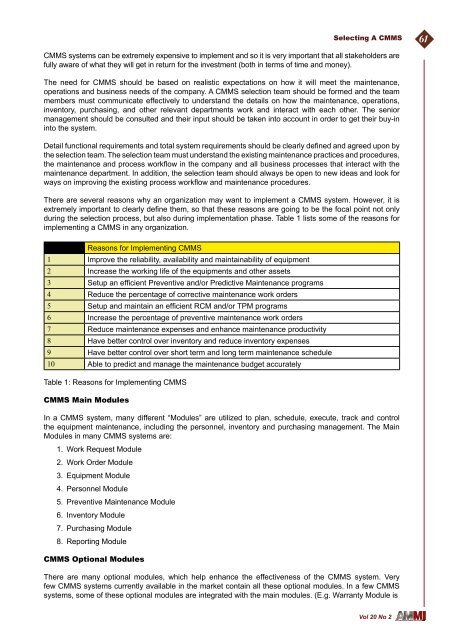April - Library
April - Library
April - Library
You also want an ePaper? Increase the reach of your titles
YUMPU automatically turns print PDFs into web optimized ePapers that Google loves.
Selecting A CMMS 61<br />
CMMS systems can be extremely expensive to implement and so it is very important that all stakeholders are<br />
fully aware of what they will get in return for the investment (both in terms of time and money).<br />
The need for CMMS should be based on realistic expectations on how it will meet the maintenance,<br />
operations and business needs of the company. A CMMS selection team should be formed and the team<br />
members must communicate effectively to understand the details on how the maintenance, operations,<br />
inventory, purchasing, and other relevant departments work and interact with each other. The senior<br />
management should be consulted and their input should be taken into account in order to get their buy-in<br />
into the system.<br />
Detail functional requirements and total system requirements should be clearly defined and agreed upon by<br />
the selection team. The selection team must understand the existing maintenance practices and procedures,<br />
the maintenance and process workflow in the company and all business processes that interact with the<br />
maintenance department. In addition, the selection team should always be open to new ideas and look for<br />
ways on improving the existing process workflow and maintenance procedures.<br />
There are several reasons why an organization may want to implement a CMMS system. However, it is<br />
extremely important to clearly define them, so that these reasons are going to be the focal point not only<br />
during the selection process, but also during implementation phase. Table 1 lists some of the reasons for<br />
implementing a CMMS in any organization.<br />
Reasons for Implementing CMMS<br />
1 Improve the reliability, availability and maintainability of equipment<br />
2 Increase the working life of the equipments and other assets<br />
3 Setup an efficient Preventive and/or Predictive Maintenance programs<br />
4 Reduce the percentage of corrective maintenance work orders<br />
5 Setup and maintain an efficient RCM and/or TPM programs<br />
6 Increase the percentage of preventive maintenance work orders<br />
7 Reduce maintenance expenses and enhance maintenance productivity<br />
8 Have better control over inventory and reduce inventory expenses<br />
9 Have better control over short term and long term maintenance schedule<br />
10 Able to predict and manage the maintenance budget accurately<br />
Table 1: Reasons for Implementing CMMS<br />
CMMS Main Modules<br />
In a CMMS system, many different “Modules” are utilized to plan, schedule, execute, track and control<br />
the equipment maintenance, including the personnel, inventory and purchasing management. The Main<br />
Modules in many CMMS systems are:<br />
1. Work Request Module<br />
2. Work Order Module<br />
3. Equipment Module<br />
4. Personnel Module<br />
5. Preventive Maintenance Module<br />
6. Inventory Module<br />
7. Purchasing Module<br />
8. Reporting Module<br />
CMMS Optional Modules<br />
There are many optional modules, which help enhance the effectiveness of the CMMS system. Very<br />
few CMMS systems currently available in the market contain all these optional modules. In a few CMMS<br />
systems, some of these optional modules are integrated with the main modules. (E.g. Warranty Module is<br />
Vol 20 No 2
















